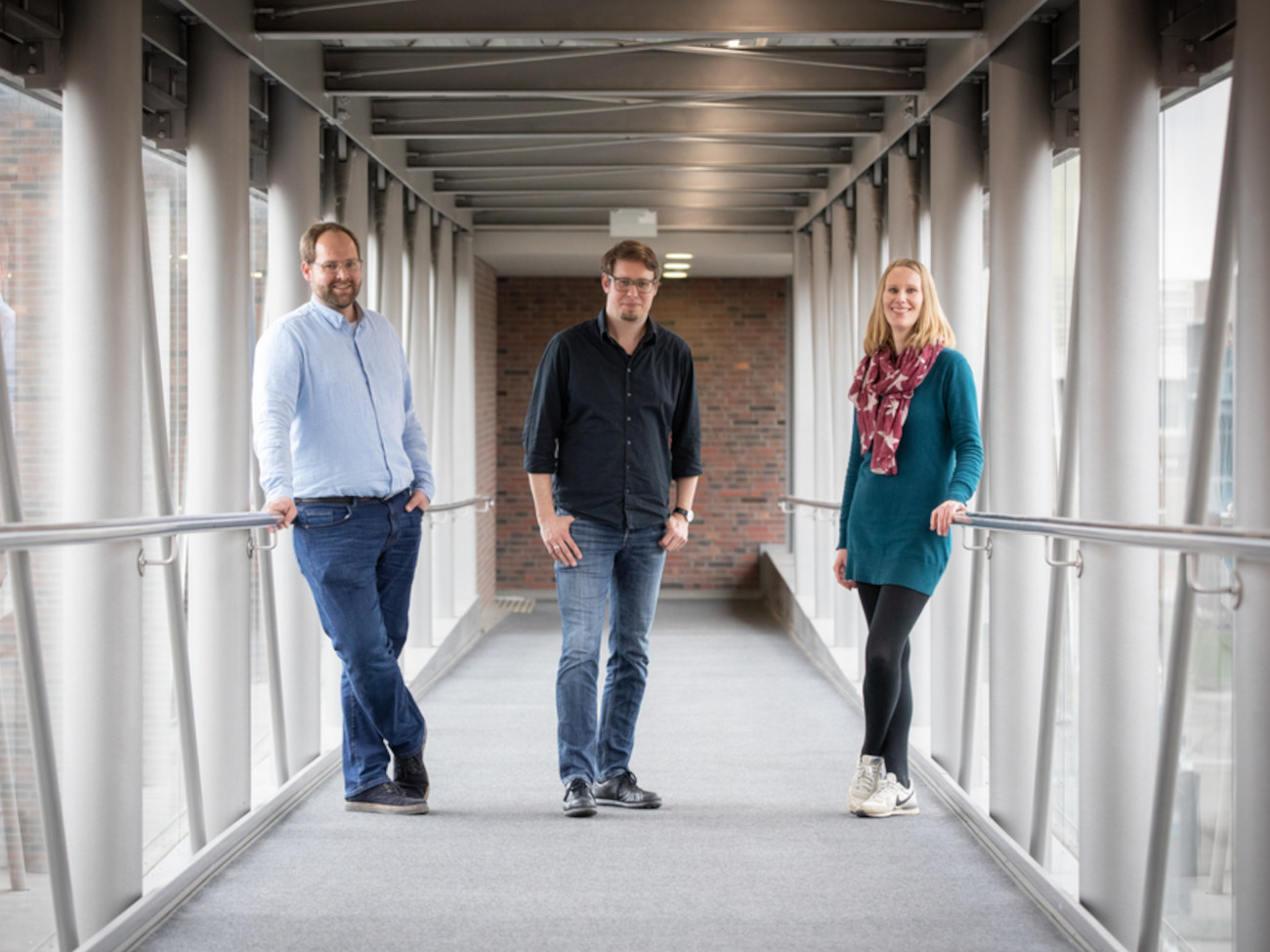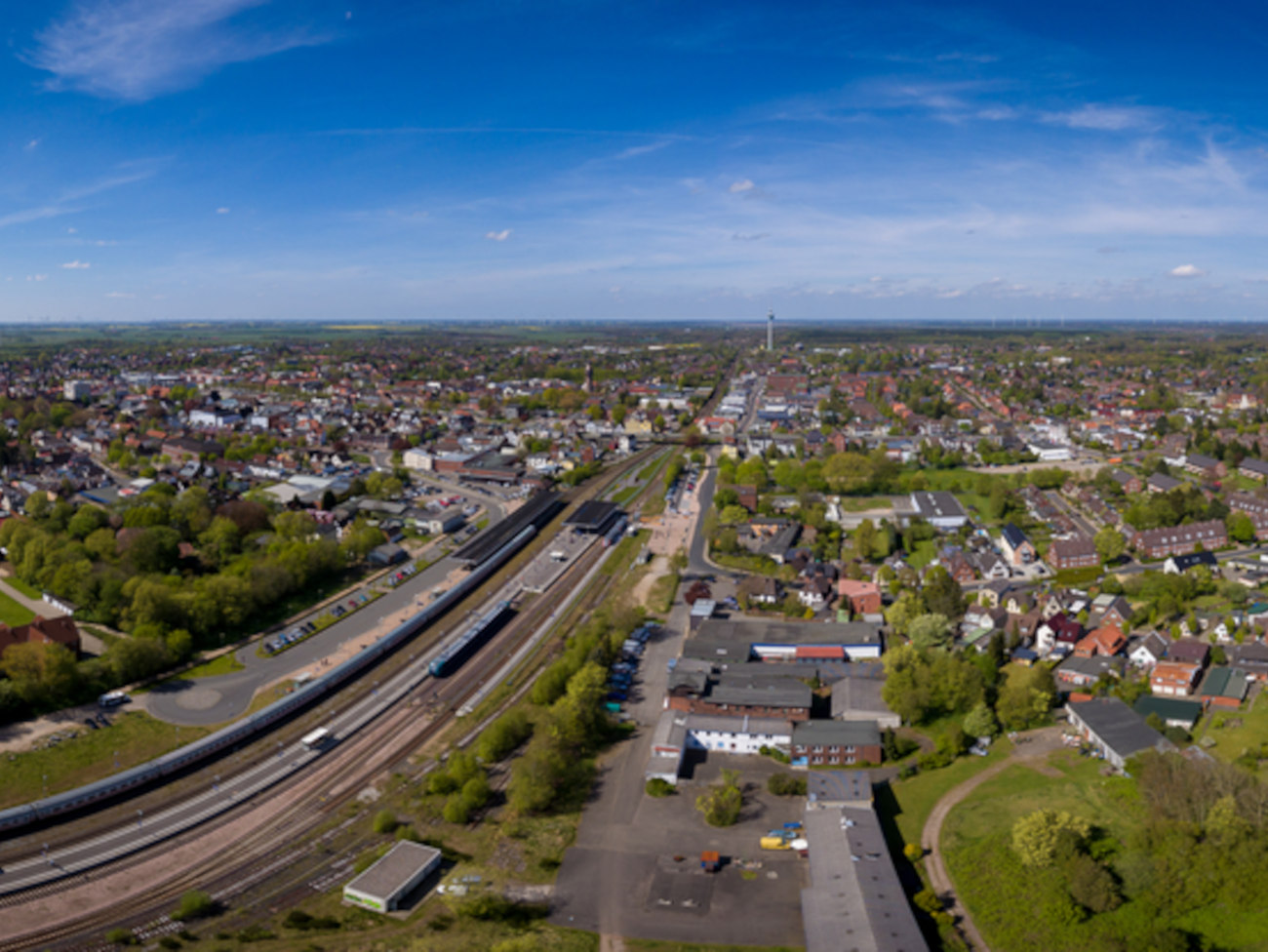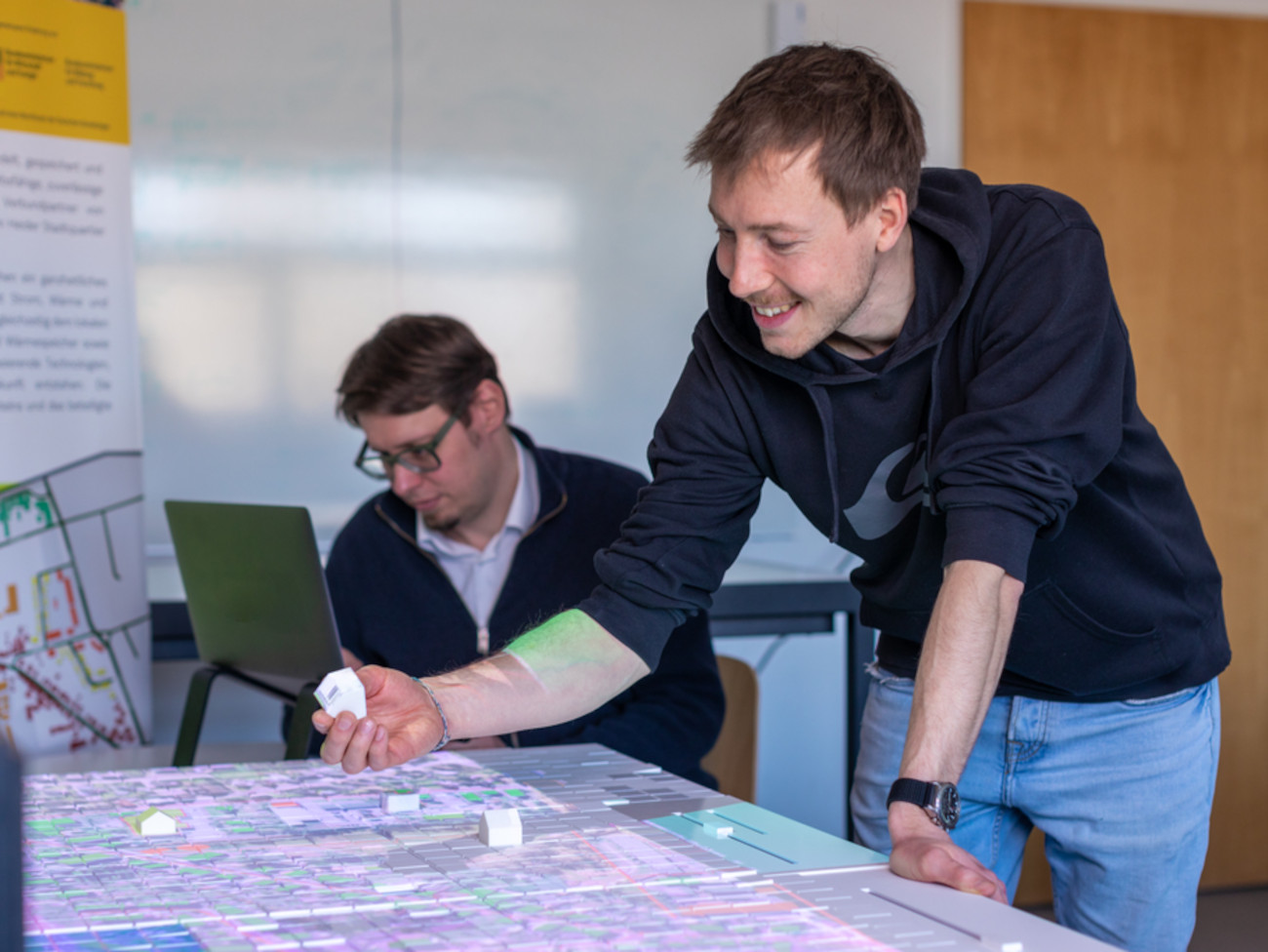
© Jens Lehmkühler / U Bremen Research Alliance
The Climate-Neutral City District – Here's How It Could Work
The transition of our energy system to 100 percent renewable energy is more urgent than ever.
Using the example of the Rüsdorfer Kamp neighborhood in Heide, researchers from the U Bremen Research Alliance are developing solutions that are sustainable, resilient, and transferable as part of the “Quarree100” project. Not only should as many people as possible benefit from the knowledge, but they should also be able to broaden it – via open science.
The wind usually blows from the west, coming from the North Sea, and often with considerable force across the flat Dithmarscher Land. The locals speak of a “stiff breeze,” which can also be recognized by the fact that many wind turbines stand still – a paradox that not only irritates tourists from the south who are vacationing here. On windy days, the electricity generated by the wind turbines overloads the grid, and only shutdowns keep it stable. 3750 gigawatt hours were lost in this way in 2019, and almost 400 million euros in compensation had to be paid by the state to the operators.
That is about to change. One goal of Quarree100 is to no longer waste energy, but to store surplus wind energy and relieve the overall system. The project’s coordinator, Dr. Torben Stührmann, puts the overarching concern this way: “We want to make the portfolio CO2-neutral as quickly as possible.” Stührmann is acting team leader of the Resilient Energy Systems department at the University of Bremen, a member institution of the U Bremen Research Alliance.
“We want to make the portfolio CO2-neutral as quickly as possible” Dr. Torben Stührmann
The portfolio, two-thirds of which are single-family homes, also includes commercial and multi-family buildings, spread across a 20-acre site. Some of the houses are a hundred years old and more, many date from the post-war period. Most of the heat for the 600 or so residents is produced by oil and gas heating systems; at 56 percent, the heat supply is the largest contributor to CO2 emissions. “The neighborhood represents many in Germany,” Stührmann emphasizes. “Rüsdorfer Kamp has a lighthouse character, and the models developed here can be transferred to other regions.”
The researchers have defined seven work packages, which also incorporate scientists from the Fraunhofer Institute for Manufacturing Technology and Advanced Materials IFAM, also a member institution of the U Bremen Research Alliance. These include data collection and energy concept development, citizen participation, infrastructures and systems, the development of new technologies, and the investigation of the regional economic effects of the measures. A total of 20 partners are involved in the project, which is being funded by the German Federal Ministry of Economics and Climate Protection and the German Federal Ministry of Education and Research with 24 million euros.

© Jens Lehmkühler / U Bremen Research Alliance
Part of the money will be used to set up a district heating network, which as many residents as possible should join as quickly as possible. It is an important building block in the researchers’ toolbox. Another is the construction of an energy center. “It will supply the neighborhood with heating energy via a heat pump,” says Benedikt Meyer, an engineer for environmental technology at the University of Bremen and head of one of the project’s work areas. It also additionally consists of a combined heat and power plant and a gas boiler for backup.
The heat pump is primarily powered by wind electricity. Photovoltaic systems on a good half of the house roofs will produce further electricity, for domestic use and to feed into the grid. Excess energy will be temporarily stored in batteries or used to generate hydrogen. “The system has to be flexible,” Meyer says. “The more flexible it is, the better.”
The approach has the entire neighborhood in mind. No house is considered on its own; it’s about the big picture. Residents and businesses are involved in its design. “The transformation of the energy system will only work if they have a say in the planning and stand behind the solutions,” says Stührmann. Workshops and neighborhood meetings are used to exchange ideas, and a digital, interactive planning table is also used. It makes it possible to call up a wide range of data and works on the principle of “what happens if…” “The point is to develop scenarios together and make the changes clear and comprehensible,” says Stührmann. Participants can also select their house on the table and see how their energy costs will develop if they do not participate and what the consequences will be for the neighborhood.
“We have been working together closely and in a trusting manner for a long time, which is very useful for the project.” Benedikt Meyer
Reactions range from skepticism to active participation, and cost is a recurring theme. “The conversion initially involves higher costs,” admits Stührmann. “In return, you get greater security of supply, CO2 neutrality, and an upgrade of your own property and neighborhood.” And, in the long run, more favorable prices.
For the researchers, this pioneering project is not only exciting because they are making a contribution to the energy transition. Above all, it is exciting because they have developed a model kit for the transformation of the energy system based on a large amount of data, which has never existed in this form before. “In the past, many research institutes developed their own models and kept them to themselves,” says Meyer. „We relied on open science. Our models are freely available, and others can use them and develop them according to their needs. The more people who work on it and contribute their ideas, the better.”

© Quaree100 / U Bremen Research Alliance
For example, one model deals with the issue of how to design an energy center that is as CO2-neutral and cost-optimal as possible. Parameters such as the heat demand of the buildings, the available energy sources, or the costs for a heat pump or a natural gas boiler are incorporated into it. “In the end, the model creates an optimal system for the desired goal, which, for example, determines the necessary power output of a combined heat and power plant and a heat pump for this purpose,” Meyer explains.
Another, Germany-wide model specifies the input data for the energy center. What does the electricity cost? How is the CO2 impact distributed over the day – when is the electricity “green,” when is it “black”? Together with the Fraunhofer IFAM, a model for the design of heating networks was also developed. “That’s where the institute has decades of experience,” says Meyer. “We have been working together closely and in a trusting manner for a long time, which is very useful for the project.”
Fraunhofer IFAM is also contributing a concept for recording the regional economic effects. “We use our model to calculate both the value added generated by the investment and operation of the plants and the employment effects in the region,” says Anne Nieters from Fraunhofer IFAM. The economist heads the “Economic and Legal Analysis and Development of Business Models” work area at Quarree100. She expects a regional gross value added of around 20 million euros.

© Jens Lehmkühler / U Bremen Research Alliance
So, there’s no doubt that Rüsdorfer Kamp and the town of Heide are benefiting economically and ecologically from the project – just as the entire region is now benefiting from wind power. A whole series of research and development projects have now settled on the west coast of Schleswig-Holstein, for example for the production of hydrogen or synthetic fuels for aircraft. The most recent success is the construction of a battery factory with several thousand jobs.
A prerequisite for this transformation is energy security. The transformation can only succeed if the energy system functions not only in stiff breezes but also in dark lulls, when the wind does not blow and the sun does not shine. To test the resilience of the system, the researchers are building a digital twin and confronting it with a wide variety of disruptive events. “No one has to fear a cold shower in the morning,” Stührmann states. “All our results show: A CO2-free energy supply is possible.”
Boosting the Potential of Combined Heat and Power Generation
On the path to climate neutrality, a significant expansion of local and district heating is required in North Rhine-Westphalia. This is one of the results of a study carried out by Fraunhofer IFAM together with project partners for the North Rhine-Westphalia State Office for Nature, Environmental and Consumer Protection. The potential of combined heat and power (CHP) for general heat supply as well as energy-intensive industry in local and district heating was investigated in various scenarios. In CHP, electricity and heat are generated simultaneously. According to the authors, climate-friendly and flexible CHP technologies will continue to play a very important role in the energy system in the future. The study also identifies potential district heating expansion areas at the municipal level and provides the relevant data basis for this.
This article comes from Impact – The U Bremen Research Alliance science magazine
The University of Bremen and twelve non-university research institutes financed by the federal government cooperate within the U Bremen Research Alliance. The joint work spans across four high-profile areas and thus from “the deep sea into space.” Biannually, Impact science magazine provides an exciting insight into the effects of cooperative research in Bremen (in German).